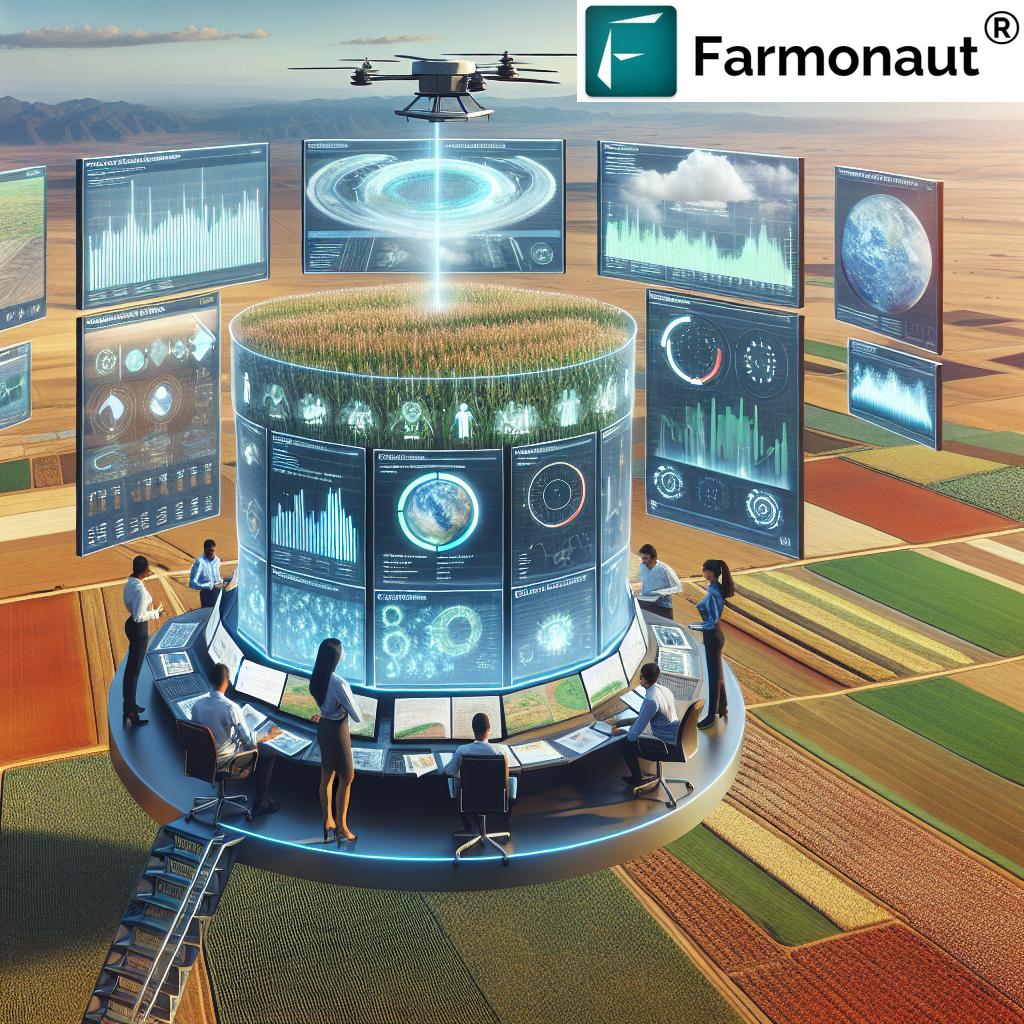Biotechnology in Sustainable Agriculture: 7 Innovations Shaping India’s Future in 2025
Introduction: The Critical Role of Biotechnology in Sustainable Agriculture Next Decade
Biotechnology in sustainable agriculture next decade is shaping the future of farming, especially as the global population continues to rise and climate, soil, and water-related challenges intensify in India. In 2025 and beyond, we witness biotechnology standing at the forefront of agricultural transformation by offering innovative solutions and advanced applications that boost productivity, crop resilience, ecological balance, and environmental sustainability.
Biotechnology in modern agriculture encompasses scientific tools, including genetic engineering, molecular markers, and tissue culture, aimed at improving yields, pest and disease resistance, and adaptation to adverse environmental conditions. These biotechnology applications are particularly pertinent in India’s diverse agricultural landscape, where smallholder farmers face the ongoing need to cultivate more output with fewer resources while reducing reliance on chemical inputs.
The integration of ai technology in agriculture in India—such as data analytics, machine learning, and satellite imagery—further enhances the impact of biotechnology. Together, they address the pressing challenges of climate change, soil degradation, water scarcity, and food security.
Let’s embark on a journey through the key agricultural biotechnology innovations that are not just addressing today’s challenges but are also future-proofing Indian agriculture for 2025, supporting our sustainable and ecological goals!
Trivia: Biotech Innovations Transforming Indian Agriculture
7 Biotechnological Innovations Shaping Indian Sustainable Agriculture’s Future
India’s journey toward sustainable agriculture is largely defined by seven pioneering biotechnological solutions. Each innovation offers unique approaches and technologies to overcome agricultural challenges, improve soil and environmental health, and increase yield and farmer livelihood security.
-
1. Genetically Improved Drought and Salinity-Tolerant Crops
Drought and salinity consistently threaten vast swathes of Indian farmlands, especially in regions like Gujarat, coastal Andhra Pradesh, and Tamil Nadu. The application of biotechnology in sustainable agriculture next decade is most evident here—with genetic engineering and CRISPR gene editing enabling scientists to create crop varieties that thrive in adverse conditions.
- This includes GM rice and wheat with salinity tolerance, being tested in Indian coastal regions.
- These varieties help stabilize yields and expand arable land into previously uncultivable, marginal areas.
- Drought-tolerant pulses and millets reduce water input and dependence on irrigation, key for resource-scarce regions.
Example: Drought-tolerant BT cotton, salt-tolerant rice lines, and CRISPR-edited wheat are pioneering examples deployed or field-tested in India to enhance food security and productivity.
-
2. Biofertilizers: Eco-friendly Soil Nutrient Management
Biofertilizers harness living micro-organisms to promote soil and plant health, representing a biotechnological leap that addresses the need to reduce chemical inputs. India’s soils, often degraded due to excessive chemical fertilizer use, benefit immensely from these eco-friendly solutions.
- Biofertilizers such as Rhizobium, Azotobacter, and Azospirillum fix atmospheric nitrogen, enhancing soil fertility.
- Mycorrhizal fungi and phosphate-solubilizing bacteria make essential nutrients available to plants, reducing chemical dependency.
- Adoption is growing in vegetable, paddy, and pulse cultivation, thanks to government support and increased awareness.
Key sustainable advantage: Minimizes environmental pollution, maintains ecological balance, and supports long-term farming productivity.
-
3. Biopesticides: Natural Crop Protection
Traditional chemical pesticides pose risks to the environment, food safety, and beneficial organisms. Biopesticides—another critical development in agricultural biotechnology applications—are gaining favor in Indian farming. Derived from plants, bacteria, fungi, or natural predators, these products protect crops without harming human health or biodiversity.
- Bacillus thuringiensis, neem extracts, and Trichoderma are widely used examples of Indian biopesticides.
- They help reduce pesticide residues in food crops—supporting both food safety and export quality.
- Biopesticide adoption has been prioritized under India’s National Mission for Sustainable Agriculture.
-
4. Gene Editing and Marker-Assisted Breeding
Gene editing technologies like CRISPR-Cas9 and marker-assisted selection are transforming crop improvement in India by enabling precise breeding and rapid trait incorporation. Unlike conventional genetic modification, gene editing offers faster development, lower regulatory hurdles, and greater public acceptance.
- Key targets: Disease resistance (like bacterial blight in rice), drought, and pest resilience in pulses and oilseeds.
- Marker-assisted breeding in maize and rice rapidly integrates qualities like early maturation or superior grain quality.
-
5. Biofortification – Nutrient-Enriched Staple Crops
Addressing malnutrition remains a significant challenge in Indian agriculture. Biofortified crops—developed through biotechnological tools to contain higher levels of vitamins and minerals—offer a solution for enhancing food and nutritional security in vulnerable communities.
- Iron-, zinc-, and provitamin-A fortified rice, wheat, and pearl millet varieties are increasingly cultivated in India.
- Selective breeding and genetic engineering ensure sustained nutrient density even under adverse environmental conditions.
- Supports India’s food security and health, particularly among children and women in rural areas.
-
6. AI, IoT & Remote Sensing for Precision Agriculture
Integration of AI technology in agriculture in India is revolutionizing sustainable farm management. Technologies like machine learning, IoT sensors, and satellite remote sensing merge with biotechnology innovations to provide real-time insights and precision interventions.
- Accurately monitor crop growth, soil fertility, and water stress using satellite imagery (such as NDVI) and in-field sensors.
- AI-powered platforms recommend optimal biotech-informed practices: irrigation scheduling, pesticide usage reduction, and resource optimization.
- Farmonaut’s satellite-powered platform provides large-scale farm management, carbon footprint tracking, and API integration—enabling both individual farmers and agri-businesses to further enhance efficiency and sustainability.
-
7. Blockchain Traceability & Digital Tools for Supply Chain Integrity
Beyond the field, biotechnology in modern agriculture includes digital solutions for food traceability and transparent supply chains—a growing need for food safety, export compliance, and consumer trust. Blockchain-based traceability tools ensure secure, tamper-proof records of crop origin, quality, and biotechnology input adoption.
- Farmonaut’s traceability product leverages blockchain to build trust from farm to table, while fleet management tools help optimize input logistics and reduce emissions.
- Digitally enabled loans and insurance (see our Crop Loan & Insurance page) also use satellite-based verification—simplifying access to credit and risk management for Indian farmers adopting biotechnology and advanced sustainable inputs.
Summary Comparison Table of Top 7 Biotechnological Innovations in Indian Sustainable Agriculture
| Innovation Name | Description | Environmental Impact | Estimated Increase in Yield (%) | Estimated Cost Savings (%) | Adoption in India (Yes/No, Hectares Covered) |
|---|---|---|---|---|---|
| GM Drought/Salinity-Tolerant Crops | Genetically engineered rice, wheat, and cotton for resilience to drought/salinity | Reduces water usage, enables farming in marginal lands, stabilizes yields | 15–30% | 10–20% | Yes, >2 million ha (mainly cotton & rice) |
| Biofertilizers | Nitrogen/phosphorus fixing microbes for plant growth, eco-friendly soil health | Reduces chemical fertilizer input, improves soil biodiversity | 5–12% | 12–18% | Yes, >5 million ha (rapidly rising) |
| Biopesticides | Microbe/plant-derived pest/disease protection alternatives | Low toxicity to non-targets, safe residues, protects pollinators | 5–10% | 8–15% | Yes, >3 million ha, expanding annually |
| Gene Editing & Marker-Assisted Breeding | CRISPR/marker technologies for targeted trait insertion in crops | Accelerates breeding, reduces input needs, enhances disease resilience | 10–25% | 8–12% | Yes, increasing pilot scale (rice, wheat, pulses) |
| Biofortified Crops | Staples bioengineered to deliver higher vitamins/minerals | Improves public health, does not increase environmental footprint | 2–7% | N/A | Yes, >1.5 million ha (especially rice, wheat, millet) |
| AI, IoT, Satellite Precision Tools | Real-time farm insights to inform biotech management (irrigation, inputs) | Minimizes input wastage, reduces emissions, higher efficiency | 8–20% | 16–25% | Yes, >5 million ha digital coverage |
| Blockchain Traceability & Digital Tools | Digital traceability for food safety, blockchain-secured supply chains | Increases supply chain transparency, reduces waste/fraud | N/A | Up to 20% | Yes, rapidly emerging (>0.8 million ha, 2024 est.) |
Farmonaut: Satellite & AI Solutions Catalyzing Sustainable Agriculture
Our mission at Farmonaut is to make satellite-driven insights affordable and accessible—empowering Indian agriculture with data that amplifies both biotech and digital innovations. We provide 

 real-time crop, soil and environmental monitoring, AI-based advisory, and blockchain traceability—all seamlessly accessible for farmers, businesses, and government users.
real-time crop, soil and environmental monitoring, AI-based advisory, and blockchain traceability—all seamlessly accessible for farmers, businesses, and government users.
-
Satellite-Based Crop Health Analytics:
Using NDVI and spectral imagery, we provide micro-level intelligence on vegetation vigor, soil water content, and potential disease outbreaks—crucial data that supports the precise application of biofertilizers, biopesticides, and other agricultural biotechnology applications. -
Jeevn AI Advisory:
On our platform, Jeevn AI offers real-time weather, pest, and soil recommendations, supporting Indian farmers’ adoption of the latest biotechnology and digital farm practices. -
Blockchain Traceability & Supply Chain Security:
Our traceability solution enables Indian food exports to comply with demanding foreign regulations, by tracking every biotech input and field operation from seed to shelf. -
Environmental Impact Tracking:
Monitor, benchmark, and reduce carbon emissions via our carbon footprinting tool—supporting Indian agriculture in achieving more planet-friendly, low-emission practices! -
Fleet and Resource Management:
Our fleet management and logistics solutions reduce operational and fuel costs for agribusinesses, driving further sustainability in the supply chain.
Integration of AI Technology in Agriculture in India: Paving a Smarter Pathway
AI technology in agriculture in India is ushering in a new era of precision farming and informed biotechnology use. With machine learning algorithms, real-time satellite monitoring, drones, and advanced data analytics, Indian farmers and agribusinesses can:
- Map soil health, pest pressure, and precise irrigation needs—maximizing the efficiency of bio-inputs and reducing reliance on chemicals
- Forecast weather and optimize decision-making for crop variety, biotech input scheduling, and harvest planning
- Leverage API integration (Farmonaut’s API and developer docs) for custom farm management platforms and advisory systems
- Drive cost savings by only applying biotech solutions where, when, and how they are needed—reducing waste and improving ROI
Biotechnology’s Role in Nutritional Security: Biofortified Crops
A critical area of focus for biotechnology in India is the development of biofortified crops for improved food and nutritional security. In 2025 and beyond, these innovations will help address malnutrition, anemia, and vitamin deficiencies especially affecting children and women in rural areas.
- Examples: Iron- and zinc-enriched rice and wheat distributed under India’s National Food Security Act;
Provitamin A-fortified maize and sweet potato supporting nutritional health in diverse regional diets. - These staple crops are bred for nutrient density without requiring extra land, water, or agrochemical inputs—supporting
both health and environmental sustainability. - Gene editing ensures nutrients remain bioavailable after cooking and storage, making biofortification suitable even in remote, resource-challenged communities.
Environmental Impact of Modern Agricultural Biotechnology Applications
As biotechnology in modern agriculture becomes more widespread in India, the ecological and sustainability benefits are increasingly apparent:
- Reduced chemical pollution: Widespread adoption of biofertilizers and biopesticides directly reduces the runoff of hazardous chemicals into soil and water, helping restore ecological balance.
- Lower greenhouse emissions: Precision farming enabled by satellite and AI (carbon footprinting tools here) allows for better resource allocation, cutting fuel use and fertilizer-associated climate impacts.
- Soil health: Biotechnology interventions like legume inoculants and mycorrhizae improve soil structure, carbon content, and microbial diversity—restoring degraded land for future food production.
- Biodiversity preservation: Biopesticides protect beneficial insects (e.g., pollinators and natural predators), while gene-edited crops can help reduce the spread of pests and crop diseases without blanket use of toxic chemicals.
The impact goes beyond the farm: transparent traceability and digital monitoring also reduce waste and fraud throughout the agricultural supply chain, aiding India’s food export economy and sustainability pledges.
The Future of Agricultural Biotechnology Innovations in 2025 and Beyond
Looking ahead to 2025 and the coming decade, the convergence of biotechnology, AI, and sustainable farming practices in India will be marked by even more sophistication, scale, and inclusivity:
- Scale-up of gene-edited and biotech crops: With improved policy clarity and regulatory support, CRISPR-edited staples and biofortified varieties will cover millions of hectares, tailored to India’s mega-diverse agro-climatic regions.
- Artificial intelligence optimization: Digital advisory tools will further automate and personalize recommendations, adapting to hyperlocal variations in soil type, climate, and farming traditions.
- Blockchain & carbon markets: Digital traceability will expand to include carbon credits—rewarding Indian farmers for measurable, biotech-driven climate action.
- Rural empowerment: Affordable mobile apps, satellite subscriptions, and digital payment platforms will bridge last-mile access gaps, democratizing both biotechnologies and the data to use them effectively.
- Resilience in the face of climate variability: With drought, floods, and new disease threats intensifying, biotechnology-driven crops and AI monitoring will be a cornerstone in safeguarding India’s food future and rural livelihoods.
FAQ: Biotechnology in Sustainable Agriculture Next Decade
-
Q: What does “biotechnology in sustainable agriculture next decade” mean for Indian farmers?
A: It refers to a suite of innovations—like gene-edited crops, biofertilizers, biopesticides, and AI-powered digital tools—that enable Indian farmers to increase yields and resilience while minimizing environmental impact and reducing resource consumption. -
Q: Are genetically modified (GM) crops safe and widely adopted in India?
A: GM cotton has been widely adopted, demonstrating yield and income benefits. Enhanced food crops like rice/wheat are under trials, with strict biosafety standards and government regulations in place for food and environment safety. -
Q: How can AI technology in agriculture help smallholder farmers be more sustainable?
A: AI, satellite imagery, and API tools give smallholders real-time insights on crop health, input needs, and weather—improving the targeting and efficiency of biotech inputs, reducing unnecessary costs and environmental risks. -
Q: What is the role of Farmonaut in supporting biotechnology and sustainability?
A: We provide satellite imagery and AI-driven solutions for crop monitoring, weather advisory, carbon footprint tracking, farm management, and blockchain-based traceability, enabling informed, data-powered adoption of biotechnology in modern Indian agriculture. -
Q: Will these innovations be affordable and accessible for all Indian farmers by 2025?
A: Rapid technological progress and digital penetration are reducing cost barriers. Subscription-based and mobile-enabled services (like those by Farmonaut) are designed to reach users from small individual farmers to large enterprises, ensuring broad access to biotechnology advancements in the coming decade.
Conclusion: Biotechnology in Sustainable Agriculture—Shaping India’s Future in 2025
In summary: Biotechnology in sustainable agriculture next decade is a powerful force for modernizing Indian agriculture—delivering increased crop resilience, productivity, and nutritional value while minimizing environmental harm. The innovative integration of advanced genetics, bio-inputs, AI, and digital monitoring is already revolutionizing how Indian farmers grow food, manage resources, and secure livelihoods.
While challenges remain—regulatory clarity on GM/CRISPR crops, investment in rural infrastructure, and farmer capacity-building—the ongoing progress ensures that sustainable, eco-friendly agricultural practices will be the norm in 2025 and beyond. With tools like Farmonaut’s satellite platform and advisory services, Indian agriculture is well-positioned to meet the dual goals of food security and ecological stewardship for generations to come.
Ready to transform your agricultural decisions with satellite, AI, and biotech tools? Download our app, explore the API, or reach out for a demonstration—Empowering you for sustainable, profitable farming in the next decade!
For industrial, government, or banking sector adoption of modern, AI-powered agricultural biotechnology applications, discover our flexible API and integration options:
• Farmonaut API (sat.farmonaut.com/api)
• API Developer Docs & Custom Integration
Farmonaut is not a manufacturer or seller of agricultural inputs, an online marketplace, or a government/regulatory organization. We provide satellite analytics, digital advisory, and traceability infrastructure for sustainable, biotechnology-driven agricultural transformation in India and beyond.
Farmonaut Subscription Services









